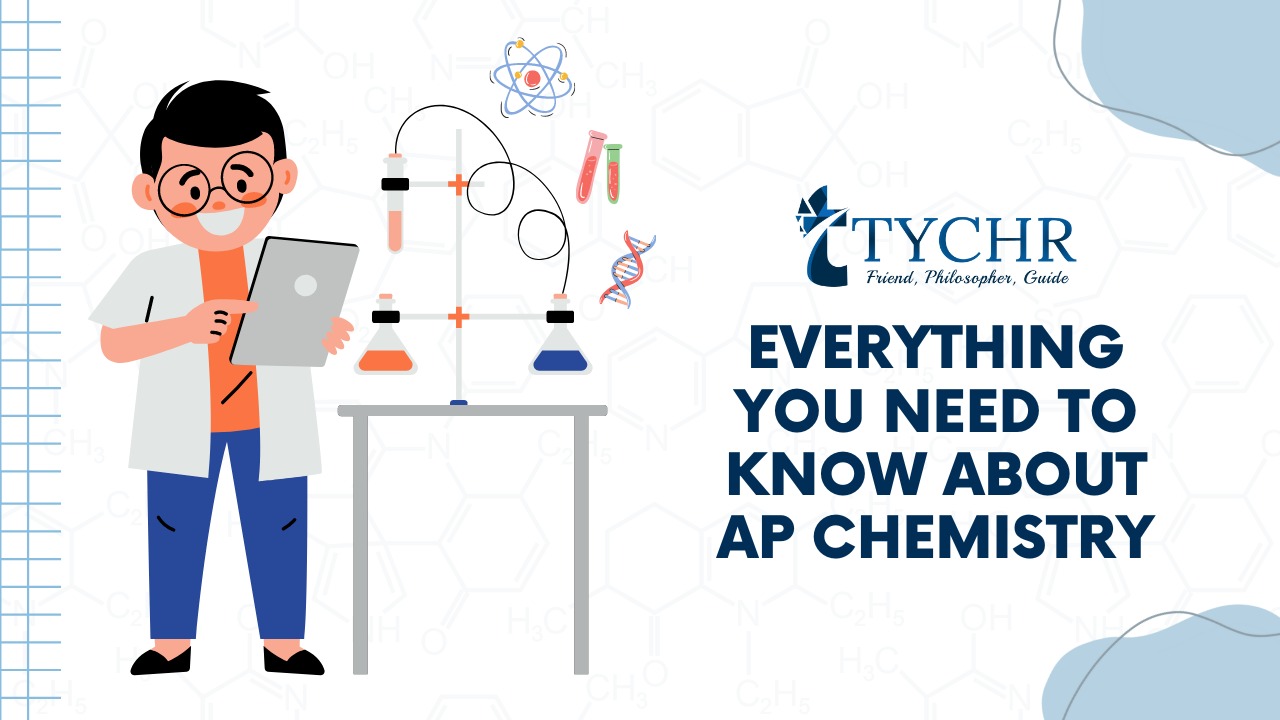Table of Contents
AP Chemistry and Why?
AP courses are essentially tougher courses that students in high school can take which would enable them to bypass certain classes during college that may be mandatory and these courses will decorate your college application showing your academic ability. The AP Chemistry subject is a one-semester class that is usually taken in the second year.
Now, AP Chemistry is one of the primary courses that is useful for several of Engineering and Sciences and for Pre-med as well. It will definitely give you a head start, and it will also enable you to skip certain courses related to it that may be mandatory during college for your major.
Here are some of your major options if you choose to study AP Chemistry:
- Pre-Medical
- Chemical Engineering
- Biochemical Engineering
- Pharmacology
- Fashion Technology and Textile Engineering
What you will learn:
When you finish an Advanced Placement Chemistry course in high school, you are eligible to take the college-level AP Chemistry Exams, which are given each May.
This is what you’ll be learning in Chemistry:
| Unit Name | What you’ll learn |
| Atomic Structures and Properties | Structure of Atoms, Periodic Trends, Mass Spectroscopy, Moles and Molar mass, Electronic Configuration |
| Molecular and Ionic Compound Structure and Properties | Types of Chemical Bonds, Lewis Diagrams, Structure of metals and ionic compounds, bond hybridization and VSEPR |
| Intermolecular Forces and Properties | States of Matter, Kinetic Molecular Theory, Intermolecular Forces, Mixtures and Solutions |
| Chemical Reactions | Stoichiometry, Reaction representation, Net Ionic Equations, Types of Chemical Reactions |
| Kinetics | Reaction rate and rate law, Collision Model, Catalysis, Reaction Mechanisms |
| Thermodynamics | Endothermic and Exothermic reactions, Calorimetry, Heat Capacity, Hess’s Law, Reaction and Formation Enthalpy |
| Equilibrium | Equilibrium Constant and Concentrations, pH solubility, Le Châtelier’s principle, |
| Acids and Bases | pH and pOH of chemicals, Molecular structure of acids and bases, Acid-Base reactions and buffers, pH and pKa |
| Applications of Thermodynamics | Entropy, Gibbs’ free energy, Thermodynamic and kinetic control, Free Energy and equilibrium, Galvanic and Electrolytic cells, Electrolysis and Faraday’s Law |
In all honesty, the syllabus size is quite large compared to other AP exams but the principles of the topics are easy to comprehend and will become easy to apply.
The Exam:
The AP Chemistry exam overall is 3 hours and 15 minutes long. It’s split into two sections – Multiple Choice, with a duration of 1 hour 30 minutes and Free Response, with a duration of 1 hour 45 minutes. There will be a short break between the two sections, and you will be allowed a calculator throughout the test (standard four-function, scientific, or graphing calculators only).
| Section | Time Duration | About the questions |
| Multiple Choice (50%) | 1 hour 30 minutes | This section has 60 questions both individual and in sets. The set of questions can pertain to the same graphic or data presentation.
Single-select questions are each followed by five possible responses, only one of which is correct. |
| Free Response (50%) | 1 hour 45 minutes | This section has 7 free response questions. Of the 7, 4 are short answer questions which are worth 4 points each while the remaining 3 are long answer questions that are worth 10 points each. The type of questions vary from analyzing data presented and deriving a result, constructing graphs, procedural writing for experiments and more.
The free-response section is graded by high school and college teachers in contrast to the multiple-choice section, which is graded by a computer. If you don’t correctly answer every part of the question, you might still receive some points for the steps because they have rules for partial credit. |
The free response section of the exam is where you want to be extremely cautious. Ensure that you prepare beforehand on what you must include in the answers for different types of questions. You also must ensure that you distribute your time evenly as certain questions in the free response section will consume a significant amount of time.
Every topic/unit has its individual weightage. The exam may have more questions from one topic than the other as the distribution is not equal. Below is a look at the nine units structured in a sequence recommended by the College Board, along with the weight each unit is given on the AP Chemistry exam:
| Unit Name | Percentage weightage in Examination |
| Atomic Structures and Properties | 7% – 9% |
| Molecular and Ionic Compound Structure and Properties | 7% – 9% |
| Intermolecular Forces and Properties | 18% – 22% |
| Chemical Reactions | 7% – 9% |
| Kinetics | 7% – 9% |
| Thermodynamics | 7% – 9% |
| Equilibrium | 7% – 9% |
| Acids and Bases | 11% – 15% |
| Applications of Thermodynamics | 7% – 9% |
Just because the weightage is different for each topic does not mean you can skim through a chapter. Make sure that you revise and go through every topic before the exam as they may ask important and tricky questions on the minor topics of each chapter and you may end up paying the price for it if you do not go through everything in the syllabus.
Grading and the Stats of the Previous Exam Session:
AP exams are graded on a scale of 1-5 where 5 is an extremely good score and the most you can receive. Colleges generally look for a 4 or 5 on the AP Chemistry exams if you want college credit, but some may grant credit for a 3 as well. AP Chemistry is notoriously known for its large syllabus and for being quite tricky. However, it’s not mission impossible to achieve a good score. See the table below to find out what percentage of students scored 1-5.
| Score | Percentage of students that scored |
| 5 | 41.6% |
| 4 | 26.4% |
| 3 | 16.3% |
| 2 | 9.2% |
| 1 | 6.5% |
What is the Pass Rate for AP Chemistry?
The percentage of students who pass the AP exam is one indicator of how challenging a particular AP class is. Scores for AP exams range from 1 to 5, with a 3 considered a passing grade like all other AP subjects. You may get a sense of how challenging the exam is for students by comparing the AP exam pass rate for AP Chemistry to the overall average. The table below shows a comparison of the pass rate and the perfect score rate for the Chemistry exam versus the average of the other AP subjects.
| AP Exam | Pass Rate (3 or higher) | Perfect Score (a 5) |
| AP Chemistry | 52.0% | 12.5% |
| Other AP classes | 64.2% | 16.8% |
The pass rate and percentage of perfect scores for AP Chemistry is relatively low compared to other AP classes. Pass rates on the AP exam, however, are not a reliable indicator of how challenging a subject is. Essentially, if you have prior knowledge of and preparation in the sciences and are prepared to challenge yourself, then the subject would pose as a less challenging obstacle to overcome. However, your goal should not to barely pass but to attain a 5 because with the pointers below, you should be able to achieve this.

How to prepare for the exam?
To boil it down, here are a few ways that you can prepare for the exam:
- A test prep book is definitely optional but a lot of the AP students use it because the book consists of practice problems and exams unique to each topic. It’s extremely useful as it will consist of types of questions that will appear in the exam and some questions that are repetitive in numerous tests.
- Formula Sheet. Very Useful. Making flash cards or having a formula sheet is an amazing way of recollecting definitions and where to apply formulas. These are an easy way to quickly revise and jog your memory on what needs to be remembered for the exam.
- Practice tests. These are available both in test prep books and online. Practice tests will provide you an idea on how questions are structured in the free response section and by doing practice tests, it will help you get a hold of how long questions may take to answer and will provide a good reflection on what you should do when you face the exam.
- Material. With. Everything. Whether it’s printouts from your teacher or online, or textbooks that contain all the information and necessary points about a topic, it’s essential that you have access to something that contains all the information about every topic in the subject. This is to ensure that you don’t miss out on any crucial points or hidden trick questions during the exam.
Here are a few tips you can keep in mind during the exam:
- Time management is crucial. Allocate an appropriate amount of time on the free-response section. Make sure you don’t spend too much time on one question and run out of time to at least try to answer all of the others.
- Prove how. If the question involves calculations, be sure to outline and include every step and process you made and devised to arrive at your answer.
- As usual, read the question carefully. Be careful and cautious with the questions. Ensure that you read the question over and over if you don’t understand it and try to go through your answers once again. Answer all the questions that you are confident that you can score 100% in first and then attempt the rest.
- Proper labeling of your diagrams and graphs. I know. It’s annoying when you lose points when you forget to label a graph or forget to include a key if it needs to be included but you have to do it. All graphs and diagrams should have appropriate labels that are both clear and accurate. Read the question carefully because it may include a graph title, unit-specific x and y axes labels, a best fit line, etc. If you don’t do as what you’re expected to do, you lose points for small mistakes and that could bite you in the back when your paper is up for grading such as by missing a 5/5 by 1 or 2 points because of the graphs.
- Give units to the numericals. It is probably the most significant thing to do in any science exam. Again, this also gets annoying as if you don’t provide units, you lose a point and it becomes frustrating. Every numerical should be expressed in its appropriate units and every chemical’s state must be specified accordingly.
- Don’t lose hope even if the first sub division is wrong. Many free-response questions have multiple parts, each of which requires a separate answer (for example, parts a, b, c, and d). Since credit is given for each part separately, you should try to solve each one. For instance, you might get zero points for your response to component a but full points for part b, c, or d. Even if the earlier response to a question is incorrect, you might still be able to get full credit for the later response if it is necessary for the answer to an earlier part of the question.
That’s a wrap on AP Chemistry and what to expect for the exams. By following the pointers above and preparing hard for the exams, you surely won’t have a hard time during the exam and could easily get a 4 or 5.







